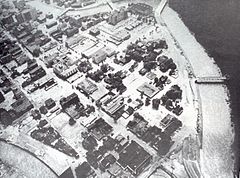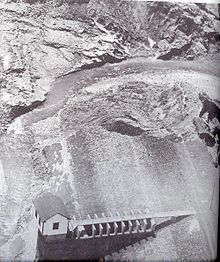Johnstown flood of 1977
 Aerial view of the flood. | |
| Date | July 19, 1977 to July 20, 1977 |
|---|---|
| Location | Johnstown area, Pennsylvania, United States |
| Deaths | 84 |
| Property damage | US$340 million (Johnstown: $137 million; surrounding areas: $213 million)[1] |
The Johnstown flood of 1977 was a major flood which began on the night of July 19, 1977, when heavy rainfall caused widespread flash flooding in Cambria County, Pennsylvania, United States, including the city of Johnstown and the Conemaugh Valley.
On July 19, a deluge of rain hit the Johnstown area during the night. Nearly 12 inches (300 millimetres) of rain fell in 24 hours when a thunderstorm stalled over the region, and six dams in the area over-topped and failed. The largest dam to fail was the
History
Johnstown
A
Response to earlier floods
Despite the devastation of the Johnstown Flood of 1889, no significant flood measures were undertaken in the aftermath. In 1936, while the U.S. Congress was debating flood control bills, heavy snow run-off and three days of continuous rainfall caused the Saint Patrick's Day flood of 1936. After this, the U.S. Army Corps of Engineers undertook a study with the aim of redesigning Johnstown's infrastructure to permanently remove any future threat of serious flooding. On April 27, 1937, Congress passed sweeping flood control legislation and in August 1938 work began with extensive dredging and other flood control measures. On November 27, 1943, the Johnstown Channel Improvement Project was declared complete, with 9.1 miles (14.6 km) of improvements that included the Conemaugh, Stonycreek, and Little Conemaugh Rivers.[6] Colonel Gilbert Van B. Wilkes, Chief of the Army Corps of Engineers, Pittsburgh District, told a Johnstown audience the flood problems had been effectively solved. The city's residents began to feel secure that any flooding issues had been resolved and even promoted the area as "flood free" for many years. However, the Corps of Engineers had designed the flood control measures for protection against a standard project flood; protection to the level necessary to control a 500-year flood was not economically viable. In 1974, the Corps issued a report titled "The Potential for Future Flooding in the Johnstown Area", which failed to grasp the attentions of town leaders and the people of Johnstown.
Dam failures

During the heavy rainfall of July 19–20, 1977, six dams failed in the Conemaugh Valley. The Laurel Run Dam on Laurel Run was an old earthen dam originally owned by the
The victims of the 1977 flooding were from
Impact on local economy
Johnstown, a once-booming steel city, was significantly impacted by the flood. In a city that relied so heavily on the steel industry in its economy, the effects of the disaster were felt for many years afterward. The Bethlehem Steel Company had roots in the industry within Johnstown. As the company continued to face a decline in profits in the years following the flood, they looked to Johnstown for solutions. With continuous cutbacks, Johnstown had ranked as the area with the least profit made. Over 2,300 steel jobs were terminated in Johnstown as a part of cutbacks initiated by Donald Trautlein, who succeeded Lewis Foy as CEO of Bethlehem Steel in 1980.[10] He invested no more money into the city as he did not see any more profit to be made.[11]
See also
- Johnstown flood of 1936
- Canal inclined plane
- Inclined plane railroad
References
- ^ NOAA:1977 damages, Retrieved 2016-01-01
- ^ Dam safety:Number of failures in 1977[permanent dead link], Retrieved 2016-01-01
- ^ NOAA flood discharge, pg. 9, Retrieved 2016-01-01
- ^ "Three Floods Later, Johnstown is Still Standing". AccuWeather. Retrieved 4 January 2016.
- ^ Ohio River Basin reference, Retrieved 2016-01-01
- ^ 1977 Johnstown area flood control, pp. 7–9, Retrieved 2016-01-01
- ^ Sanders Run Google map reference, Retrieved 2015-01-01
- ^ Johnstown victims remembered, Retrieved 2016-01-01
- ^ 1977 failure of Laurel Run dam, pp. 14–16, Retrieved 2016-01-01
- OCLC 1260340723.)
{{cite book}}: CS1 maint: location missing publisher (link - S2CID 197739210.
External links
- Johnstown Flood Museum – Johnstown Area Heritage Association
- The water supply of Johnstown
